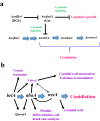The ancient koji mold (Aspergillus oryzae) as a modern biotechnological tool
- PMID: 38650252
- PMCID: PMC10992763
- DOI: 10.1186/s40643-021-00408-z
The ancient koji mold (Aspergillus oryzae) as a modern biotechnological tool
Abstract
Aspergillus oryzae (A. oryzae) is a filamentous micro-fungus that is used from centuries in fermentation of different foods in many countries all over the world. This valuable fungus is also a rich source of many bioactive secondary metabolites. Moreover, A. oryzae has a prestigious secretory system that allows it to secrete high concentrations of proteins into its culturing medium, which support its use as biotechnological tool in veterinary, food, pharmaceutical, and industrial fields. This review aims to highlight the significance of this valuable fungus in food industry, showing its generosity in production of nutritional and bioactive metabolites that enrich food fermented by it. Also, using A. oryzae as a biotechnological tool in the field of enzymes production was described. Furthermore, domestication, functional genomics, and contributions of A. oryzae in functional production of human pharmaceutical proteins were presented. Finally, future prospects in order to get more benefits from A. oryzae were discussed.
Keywords: Aspergillus oryzae; Enzymes; Food industry; Functional genomics; Secondary metabolites.
© 2021. The Author(s).
Conflict of interest statement
The authors declare that they have no competing interests.
Figures






References
-
- Ahmed A, Badar R, Khalique N. Screening and optimization of submerged fermentation of lipolytic Aspergillus oryzae. BioResources. 2019;14(4):7664–7674. doi: 10.15376/biores.14.4.7664-7674. - DOI
-
- Arnaud MB, Chibucos MC, Costanzo MC, Crabtree J, Inglis DO, Lotia A, Orvis J, Shah P, Skrzypek MS, Binkley G, Miyasato SR, Wortman JR, Sherlock G. The Aspergillus Genome Database, a curated comparative genomics resource for gene, protein and sequence information for the Aspergillus research community. Nucleic Acids Res. 2010;38:D420–427. doi: 10.1093/nar/gkp751. - DOI - PMC - PubMed
Publication types
LinkOut - more resources
Full Text Sources

